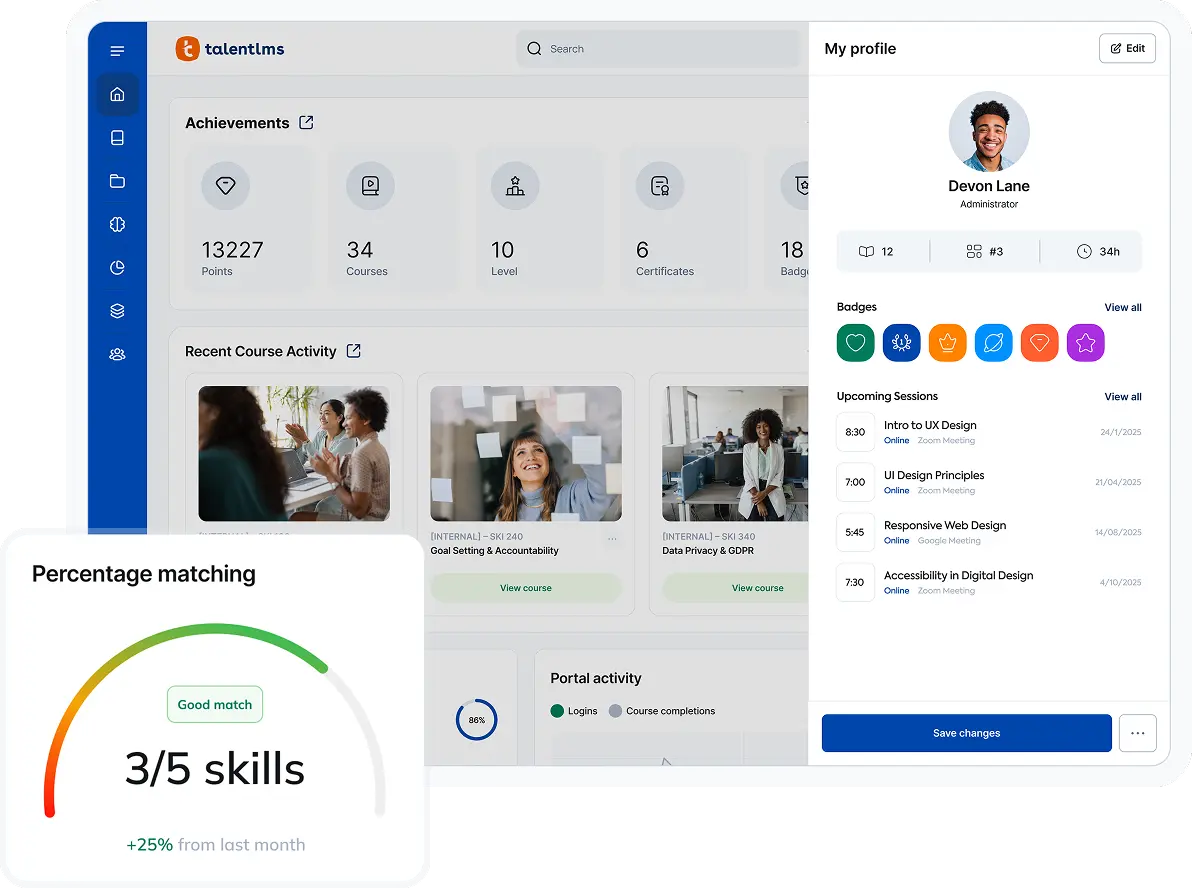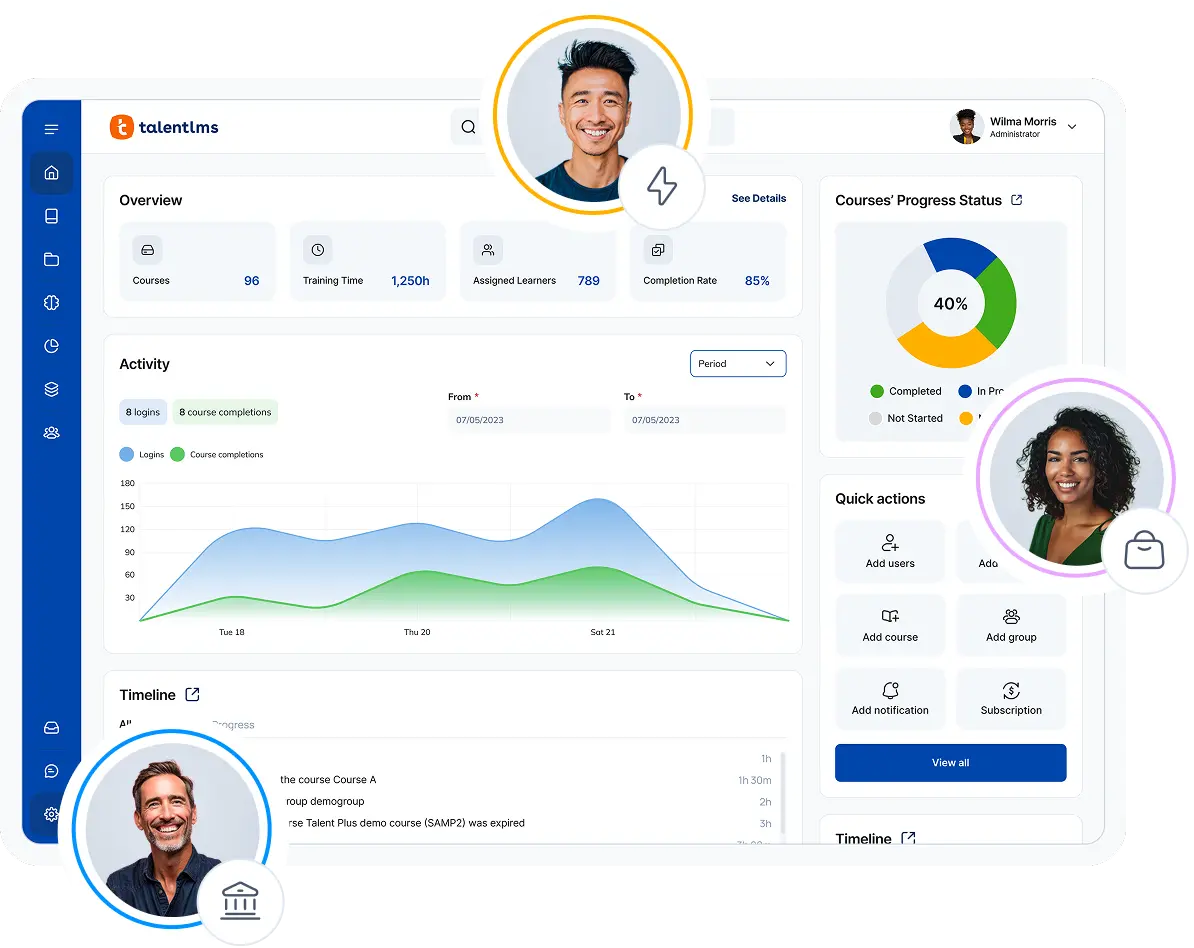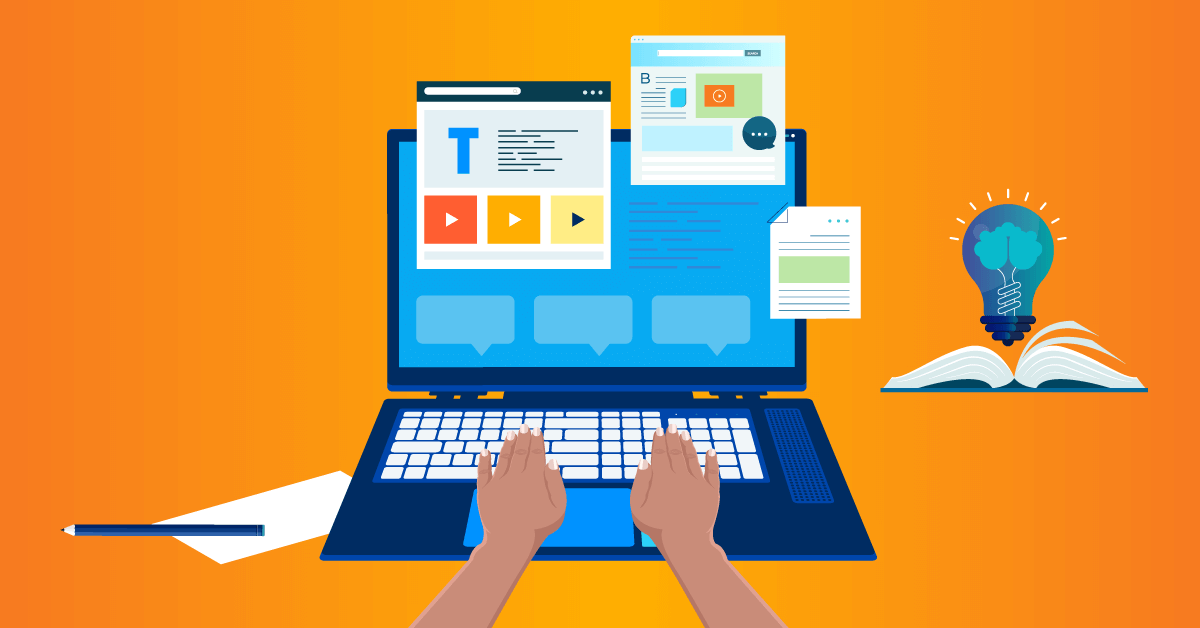Every leader responsible for talent management feels the ground shifting. The core competencies that define a great employee today become obsolete faster than we can track.
What was cutting-edge yesterday feels like standard practice today and will be outdated tomorrow.
On the TalentLMS podcast, talent expert Sagar Goel states, “This is the concept of the half-life of skills, where the number today is five years, which means every five years, half of your skills become redundant.”
The reason behind this rapid shift is artificial intelligence (AI). It acts as a catalyst, reshaping complex, cognitive roles and changing the very definition of high-value work.
To prepare your teams for this new world, you need to focus on the specific, practical skills for AI mastery that make your workforce strong and competitive.
Top 13 AI skills:
- Data literacy
- Deep learning
- Machine learning
- Prompt engineering
- AI ethics
- Critical thinking
- Developing a growth mindset
- Creativity
- Communication
- Emotional intelligence
- Strategic thinking
- AI project management
- Change management
Why should your employees learn AI?
Since AI and machine learning models were introduced to the workplace, professional work has evolved from a solo performance into a partnership. Artificial intelligence has quickly become a peer for complex tasks, further shaping every role, every position. It’s also reshaped every role and every position. AI has become an enabler, an enhancer. And with that, it’s created the demand for not only upskilling and reskilling, but also has created a new set of skills needed.
For an entire organization, that shift creates a new baseline for competitive advantage. Companies where employees integrate AI into their work, or gain AI skills, simply perform better. Additionally, their teams innovate faster, make more insightful decisions, and operate with greater efficiency.
The job market already reflects this new reality. A recent analysis from PwC’s 2025 Global AI Jobs Barometer shows that 100% of industries are increasing their AI usage. That same study states that workers with AI skills have 56% wage premium over ones without in the same job. These stats tell us that there is substantial value in the skills that define this new standard of work.
What are AI skills?
AI skills are the skills people need to either adapt to the use of AI tools or skills needed to build and manage AI models and systems.
In practice, they fall into two groups: everyday users (most people) who use AI tools to do their jobs better, and technical users (specialists) who create and manage AI systems.
These skills combine technical fluency (i.e., the practical ability to use and manage AI tools) with adaptive intelligence, which applies creativity, strategic thinking, and problem-solving in ways that AI supports, not replaces.
Effective AI skills are built through formal AI skills-based training, creating clear development paths for a resilient workforce.

What AI skills are in demand?
While the field of AI is vast, the following in-demand AI skills create the most immediate business value.
1. Data literacy
Data literacy is the ability to question, interpret, and communicate insights from AI tools. According to research by Qlik, a major confidence gap exists. While 85% of executives see it as a vital future skill, only 11% of employees feel fully confident in their abilities, spotlighting an urgent training need.
Example: A sales manager uses AI-generated dashboards to identify which customer segments drive the highest revenue and adjusts campaign budgets accordingly.
2. Deep learning
Deep learning powers many sophisticated AI models, from chatbots to image recognition. Marketing, product, and strategy teams need to understand their capabilities and limits to guide the tools they now use every day.
Example: A data scientist builds a deep learning model to automatically tag thousands of product photos, helping the retail merchandising team update listings faster.
3. Machine learning
Machine learning (ML) is the skill of teaching systems to find patterns within your company’s data to make intelligent predictions about future outcomes. It’s the engine behind accurate sales forecasts and identifying at-risk customers, turning raw business data into a clear strategic advantage.
Example: A data analyst trains a machine learning model to predict which customer accounts are likely to churn, enabling the customer success team to act early with targeted retention campaigns.
4. Prompt engineering
Prompt engineering is the skill of giving generative AI structured, context-rich instructions. An effective prompt turns a simple query into a strategic command.
The result is a more reliable and nuanced output.
Example: A marketer crafts a precise prompt to generate five email subject line variations tailored to different buyer personas.
5. AI ethics
AI ethics means actively looking for hidden risks in generative AI tools, from biased decision-making to data privacy violations.
A KPMG survey found that 61% of people are concerned about AI risks like data security and algorithmic bias. Addressing these concerns is a business imperative, and building the necessary awareness requires dedicated instruction through a formal AI ethics course.
Example: An HR team audits an AI hiring tool to ensure it doesn’t favor certain demographics when screening resumes.
TalentLibrary — Skills that matter, courses that deliver
With TalentLibrary, you set the foundation for a strong, aligned workforce—soft skills, compliance, and workplace essentials, from day one (and beyond).
6. Critical thinking
In an age where AI generates answers instantly, the real value shifts to the human skill of questioning those answers. Critical thinking is the essential counterbalance to automated output. It’s the ability to validate information, challenge assumptions, and strategize based on insights generated by AI.
The World Economic Forum’s “Future of Jobs” report consistently ranks this as a top in-demand skill, confirming its urgent priority for every business.
Example: A content writer reviews AI-generated copy for relevance and brand accuracy, keeping useful ideas while removing off-brand or misleading content.
7. Developing a growth mindset
A growth mindset is less a single skill and more a collection of crucial traits, including agility, adaptability, and resilience. In an era of constant technological change, it is the foundational operating system for an employee’s long-term success, and it might be the single most important capability for a modern workforce.
A growth mindset is the belief that skills are built, not fixed, which encourages continuous learning. A study by TalentLMS on the Growth Mindset in the Workplace confirms the business impact, finding that 80% of executives agree an employee’s growth mindset directly contributes to revenue growth.
Example: An employee experiments with new AI tools each quarter to stay ahead of industry changes instead of sticking to old workflows.
8. Creativity
AI can generate endless variations on existing patterns, but it can’t replicate human imagination. True creativity is the skill of asking novel questions and connecting disparate ideas to create something entirely new. It’s the engine of innovation, a quality that separates market leaders from the rest of the pack.
Example: A designer uses AI to produce dozens of layout options, then combines elements from several to craft an original campaign concept.
9. Communication
Communication is the essential last-mile skill for any AI initiative. The most powerful data-driven insight has no value if it can’t be understood.
The ability to translate complex findings into a clear, persuasive story for stakeholders is what turns a promising data analysis into a funded and supported project.
Example: A product marketer summarizes AI performance data from user testing into a short report that helps leadership decide whether to roll out a new feature.
10. Emotional intelligence
As AI automates routine tasks, the value of human connection skyrockets. Emotional intelligence (EQ) is the skill of inspiring, persuading, and empathizing with colleagues and customers. A study found that leaders with high EQ were significantly more likely to have high-performing teams, making it a critical skill for collaboration.
Example: A team leader helps employees adapt to new AI tools by listening to concerns and building trust through empathy and transparency.
11. Strategic thinking
Strategic thinking is the ability to use AI-driven insights to see the bigger picture. An AI can optimize a process, but it takes a human to connect that output to long-term business goals and anticipate market shifts. The AI supplies the detailed map, but a human strategist still has to choose the destination.
Example: An email specialist uses AI to analyze campaign performance, identify what works best, and standardize successful practices across all future campaigns.
12. AI project management
AI projects are often experimental, not linear, and many fail before they launch. VentureBeat reports that 87% of AI initiatives never make it into production. The skill of AI project management is about navigating that uncertainty. It involves managing fluid timelines, fostering rapid iteration, and acting as the translator between technical teams and business leaders.
Example: A project manager coordinates between data scientists, engineers, and marketing teams to test and refine an AI recommendation engine, adjusting timelines as the model evolves and performance improves.
13. Change management
New tools are only effective if people use them. Change management is the skill of guiding teams through the human side of a technological shift, which often meets a lot of employee resistance.
Actively involving employees in redesigning their roles with AI is the surest way to build buy-in.
Example: An operations leader plans the rollout of an AI-powered scheduling system by redesigning workflows, training team leads on the new process, and tracking adoption metrics to ensure the transition succeeds.
How to train for AI skills
Knowing which skills to build is the first step. The next step is the how to learn AI skills part by creating a practical plan to develop them across your organization.
1. Start with structured programs
Leaving employees to learn AI on their own leads to fragmented, inconsistent results. A far better approach is to build a structured, company-wide program that gives everyone a clear framework for the essential AI skills to learn.
Skills-based training is the perfect methodology for this. It allows you to design targeted learning paths that align directly with specific, high-value career goals in an AI-driven environment.
2. Address the speed gap between AI and training
Your annual training plan is probably already out of date. It’s a sentiment backed by the Annual L&D Benchmark TalentLMS report found that 49% of employees feel AI is advancing faster than their company’s training can keep up. That reveals a core conflict — technology sprints, while traditional training models walk.
The solution is two-fold: create online courses faster and changing what you teach.
Instead of focusing on static knowledge that will soon be obsolete, the priority must shift to teaching people how to learn with constantly evolving tools, turning your L&D team from a content library into a hub for agility.
3. Focus on continuous, lifelong learning
Training can’t be a one-time event when the technology itself is always evolving. The only sustainable approach is to build a culture of continuous learning. Such a culture starts when leaders visibly model the behavior by openly sharing their own learning journeys with new tools.
As Sagar mentions in the TalentLMS “Employee Reskilling” podcast, “Creating a culture of reskilling lets learning become part of day-to-day work, not just a yearly check box.”
Making that a reality means giving your teams the explicit time and permission to explore, making learning a tangible and rewarded part of the job itself.
4. Provide accessible, ready-made courses
A learning culture needs a system to run on, and a central employee training software or LMS is that system. It removes friction, standardizes the learning experience, and makes your training efforts scalable across the entire company. You don’t need to build every course from scratch, which is a slow and difficult process.
A more agile approach is to use high-quality, ready-made courses, like the ones in TalentLibrary’s AI Essentials collection. You can then use a skills-based training tool to map these courses directly to specific job roles and competencies. That connection creates clear, personalized development paths for every employee, turning a broad training initiative into a targeted and effective strategy.
5. Encourage blended learning approaches
Relying on a single training method for a topic as complex as AI is a mistake. A much better approach is to blend different styles.
Use instructor-led sessions to tackle tough questions, encourage peer learning for collaborative problem-solving, and use self-paced courses to cover foundational knowledge.
A mixed training program keeps the training experience human and flexible, and it recognizes that different people learn in different ways, making your entire program more effective.
6. Measure and adapt your strategy
Your training program should be as agile as the technology it covers.
To do so, move beyond simple completion rates and measure what really matters, like how new skills are being applied on the job and the impact on business goals. Create a continuous feedback loop, actively asking your teams what’s working and what needs to change.
Use that feedback to constantly iterate on your program, assuring it evolves right alongside the technology.
Build the ultimate advantage
Building an AI-ready workforce is an investment in your company’s ability to lead, not just survive. It’s about equipping your teams to move past simple efficiency and use AI systems to uncover entirely new revenue streams and customer solutions.
A team that blends technical skill with deep human insight can anticipate market shifts before they happen, turning constant change into a powerful advantage.
Ultimately, while your competitors can buy the same software, they cannot replicate the collective creativity and strategic judgment of a well-trained, human-centered team.



![15 Best Employee Training Tools 2024 + [Free Options]](https://www.talentlms.com/blog/wp-content/uploads/2024/07/Best-employee-training-tools.png)

